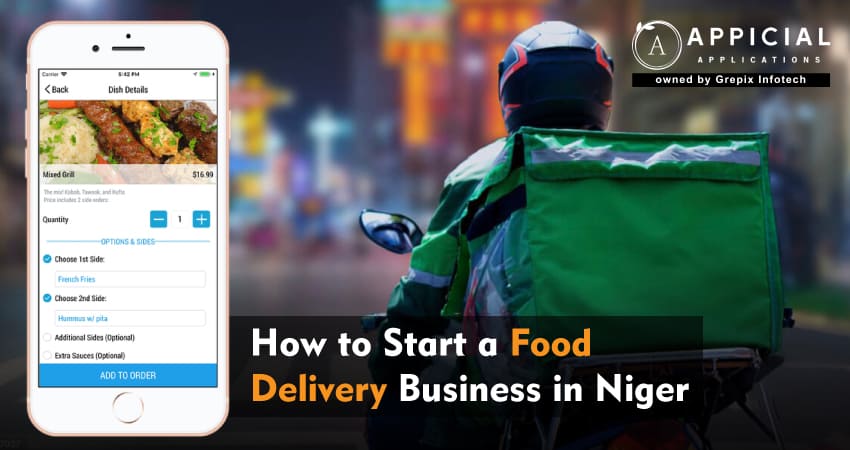
How to Start a Food Delivery Business in Niger
Over the past decade, Niger has been quietly transforming. Cities like Niamey, Zinder, and Maradi have grown, not just in size, but in lifestyle. More offices, more universities, and busier schedules have reshaped how people eat. Instead of spending hours cooking or commuting to restaurants, many want meals brought straight to their door.
Globally, Grubhub Delivery, Uber Eats Delivery, and DoorDash Food Delivery have reshaped dining. But in Niger, the market is still in its early stages, which means there’s room for innovators. A well-built Food Delivery App tailored for local conditions could not only thrive but set the standard for how food delivery works in the country.
This guide explores why the timing is right, what features an Online Food Delivery App should have, what technology is needed, and how much it costs to get started. It also looks at market gaps and challenges, plus how a strong Food App Development Company can make the process smoother.
Niger’s food delivery market is at the edge of rapid growth, driven by urbanization, affordable mobile internet, and a young, tech-savvy population. With minimal competition, entrepreneurs have a prime opportunity to launch tailored food delivery apps that address local needs like mobile money integration, lightweight performance, and offline browsing. Essential features include quick registration, real-time tracking, multiple payment methods, and simple restaurant tools. Development costs range from $10,000 for an MVP to $70,000 for premium platforms, with a 4–6 weeks timeline. Backed by Appicial Applications’ expertise, startups can build scalable, user-friendly solutions and establish strong market leadership early.
Why Invest in Food Delivery App Development in Niger?
The idea of ordering meals from a phone is not new, but in Niger, it’s still fresh enough to be exciting. Several factors make it a strong investment right now:
1 Rising Urbanization
Urbanization in Niger is accelerating. With more people in cities, there’s a greater demand for convenient dining options. The average urban professional or student doesn’t want to travel long distances just to grab lunch.
2 Affordable Mobile Internet
Five years ago, only a fraction of the population had access to affordable mobile data. Today, data packages are cheaper, and smartphone ownership is climbing. Even in smaller towns, people are using apps daily, from messaging to shopping. Adding Food Delivery Platforms to their habits is the next step.
3 Young, Tech-Savvy Population
Niger’s median age is under 16. That means a huge portion of the population is young, adaptable, and curious about new services. They’ve seen Grubhub food delivery and DoorDash delivery App concepts online and are eager for local versions.
4 Low Competition
While the idea of a DoorDash food Delivery App is well established elsewhere, Niger has few national-level players. This opens the door for a startup to position itself as the go-to service before bigger companies enter.
Projection:
If an app captures even 5% of the urban restaurant delivery market in Niamey within the first two years, it could generate $50,000–$80,000 in annual revenue, without counting expansion to other cities.
What are the Must-Have Features for a Food Delivery App?
A Build Food Delivery App project in Niger should be simple but powerful. Overcomplicating the app will drive away first-time users.
For Customers
- Quick Registration: Let users sign up with phone number, email, or social media.
- Clear Menus with Photos: Photos encourage orders, especially for new dishes.
- Search and Filters: A user looking for “grilled chicken” should find it fast.
- Real-Time Tracking: People want to know where their food is, just like Grubhub Delivery provides.
- Multiple Payment Methods: Cash, card, and mobile money should all be available.
- Review & Rating System: Builds trust between restaurants and customers.
Example: Imagine Fatima, a university student in Niamey, who orders jollof rice on her lunch break. She needs to find it quickly, pay via Airtel Money, and see when the delivery will arrive before her next class.
For Restaurants
- Order Management: Accept or reject orders instantly.
- Menu Control: Change prices or availability in seconds.
- Sales Reports: See daily revenue and top-selling dishes.
For Delivery Partners
- Instant Job Alerts: Receive orders in real time.
- GPS Navigation: Saves time and fuel.
- Earnings Tracker: Keeps delivery staff motivated.
For Admins
- User and Partner Management: Oversee the platform’s activity.
- Commission Settings: Adjust fees per restaurant.
- Analytics Dashboard: Spot trends and improve service.
A good Online Food Delivery App in Niger doesn’t just copy Uber Eats Delivery or DoorDash Food Delivery; it adapts those ideas to the reality of local traffic, internet, and payment systems.
What is the TechnologyStack and Architecture?
For smooth operation and long-term growth, a Food App Development Company will suggest a solid tech foundation.
Recommended Stack:
- Frontend (User Interface): React Native or Flutter for mobile apps that run on both Android and iOS.
- Backend (Server Logic): Node.js or Django for fast, scalable operations.
- Database: PostgreSQL or MongoDB for storing menus, orders, and user data.
- Hosting: AWS or Google Cloud for reliability.
- Payment Gateways: Paystack, Flutterwave, or direct mobile money APIs.
- Maps: Google Maps API or Mapbox for real-time GPS tracking.
Architecture Flow:
- Customer browses restaurants and places an order.
- The order is sent to the backend, which updates the restaurant.
- The restaurant confirms and starts preparing.
- A delivery driver is assigned automatically.
- GPS tracking updates the customer until delivery is complete.
What are the Challenges and Market Gaps in Niger?
Challenges
- Internet Speed: The app must be lightweight to work well on slower networks.
- Cash Preference: Many customers trust cash payments more than cards.
- Delivery Logistics: Poor road conditions in some areas may cause delays.
- Restaurant Onboarding: Some owners may be skeptical about joining new Food Delivery Platforms.
Gaps in the Market
- No leading Grubhub food delivery equivalent in Niger.
- Few apps integrate mobile money payments.
- Limited real-time delivery tracking.
Opportunity Tip: A Create Food Delivery App that works offline for browsing menus and placing “queued” orders when the internet reconnects could win big in smaller cities.
What is the Estimated Development Cost & Timeline?
Launching a DoorDash-style delivery app platform involves several stages.
Cost Breakdown (USD):
- Basic MVP: $10,000 – $15,000 (essential features, single city launch)
- Mid-Range: $20,000 – $35,000 (advanced tracking, multiple payment options)
- Premium: $40,000 – $70,000 (AI recommendations, analytics, nationwide coverage)
Timeline:
- Planning & Wireframes: 3–4 weeks
- Development: 12–16 weeks
- Testing & Launch: 3–4 weeks
Projection: With good marketing, a mid-range $25,000 investment could reach monthly revenues of $6,000–$9,000 within two years.
How Appicial Applications Can Help?
Appicial Applications is a trusted Food App Development Company with a track record of building apps similar to Grubhub Delivery, Uber Eats Delivery, and DoorDash Food Delivery, but customized for local conditions.
Why they’re a strong choice:
- Local Adaptation: Mobile money, cash options, and offline browsing.
- Full-Service Development: From idea to launch, plus ongoing updates.
- Scalable Solutions: Can grow from a single city to national coverage.
- User-Centric Design: Ensures ease of use for first-time app users.
For entrepreneurs aiming to Build Food Delivery App projects that last, having a development partner with real-world experience is critical.
Conclusion
The demand for Online Food Delivery App services in Niger is rising, but competition is still minimal. By investing now, entrepreneurs can establish their brands before international giants arrive.
Success will depend on more than just copying the DoorDash Food Delivery App or Grubhub food delivery models. It requires local insight, lightweight tech, flexible payment options, and strong marketing. Businesses that strike the right balance can dominate the market for years to come.
FAQs
Author's Bio

Vinay Jain is the Founder at Grepix Infotech and brings over 12 years of entrepreneurial experience. His focus revolves around software & business development and customer satisfaction.
Back to blog list




